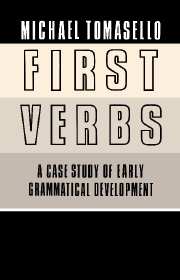Book contents
- Frontmatter
- Contents
- Acknowledgments
- Dedication
- 1 Introduction
- 2 In the beginning was the verb
- 3 Methods and an introduction to T's language
- 4 Change of state verbs and sentences
- 5 Activity verbs and sentences
- 6 Other grammatical structures
- 7 The development of T's verb lexicon
- 8 The development of T's grammar
- 9 Language acquisition as cultural learning
- References
- Appendix
- Index
8 - The development of T's grammar
Published online by Cambridge University Press: 18 December 2009
- Frontmatter
- Contents
- Acknowledgments
- Dedication
- 1 Introduction
- 2 In the beginning was the verb
- 3 Methods and an introduction to T's language
- 4 Change of state verbs and sentences
- 5 Activity verbs and sentences
- 6 Other grammatical structures
- 7 The development of T's verb lexicon
- 8 The development of T's grammar
- 9 Language acquisition as cultural learning
- References
- Appendix
- Index
Summary
In this chapter I summarize and discuss T's verbs from the point of view of her syntax and grammatical organization. In the first section I focus on sentences – particularly on the processes of symbolic integration that T used to combine her symbols into sentences and the syntactic devices she used to mark the different conceptual roles played by these symbols in various sentences types. In the second section I focus on T's grammatical organization, that is, on the Verb Island hypothesis. The question here is how generally T applied her syntactic devices across verbs – to what extent her early language shows evidence of lexically general syntagmatic and paradigmatic categories. In a third and final section I attempt to sketch out a more general perspective on processes of early grammatical development.
Before proceeding to specific analyses, Table 8.1 provides a very global overview of T's early sentences containing a relational word or verb, organized by sentence type and age in months. This is essentially a highly distilled composite of the tables depicting T's syntactic development in chapters 4 and 5. To accommodate an overall perspective in a small space, much important information is not included in this table, for example, precisely how syntactic marking is nonconventional in some cases. The specific analyses in the sections that follow provide much of this missing information.
Two terminological notes. In the analyses that follow I use the general argument categories actor (or agent), object (or theme or patient), location, instrument, and so forth for all verbs; these will be called argument types.
- Type
- Chapter
- Information
- First VerbsA Case Study of Early Grammatical Development, pp. 222 - 263Publisher: Cambridge University PressPrint publication year: 1992



